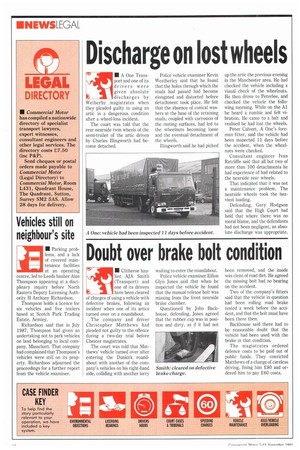Discharge on lost wheels
Page 12

If you've noticed an error in this article please click here to report it so we can fix it.
1 • A One Transport and one of its drivers were given absolute discharges by Wetherby magistrates when they pleaded guilty to using an artic in a dangerous condition after a wheel-loss incident.
The court was told that the rear nearside twin wheels of the semi-trailer of the artic driven by Charles Illingworth had become detached. Police vehicle examiner Kevin Weatherley said that he found that the holes through which the studs had passed had become elongated and distorted before detachment took place. He felt that the absence of conical washers at the base of the retaining studs, coupled with corrosion of the mating surfaces, had led to the wheelnuts becoming loose and the eventual detachment of the wheels.
Illingworth said he had picked up the artic the previous evening in the Manchester area. He had checked the vehicle including a visual check of the wheelnuts. He then drove to Peterlee, and checked the vehicle the following morning. While on the Al he heard a rumble and felt vibration. He came to a halt and realised he had lost the wheels.
Peter Calvert, A One's foreman fitter, said the vehicle had been inspected 11 days before the accident, when the wheelnuts were checked.
Consultant engineer Ivan Ratcliffe said that all but two of more than 100 detachments he had experience of had related to the nearside rear wheels.
That indicated that it was not a maintenance problem. The nearside wheels took the heaviest loading.
Defending, Gary Hodgson said that the High Court had held that where there was no moral blame, and the defendants had not been negligent, an absolute discharge was appropriate.




























































































































